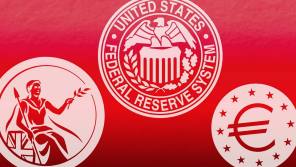
But Ian Ormiston added that recent stock market volatility was not the start of a bear market in equities.
Asked whether the falls seen in Asian, US and European markets since 2 February were a short-term correction or a long-term decline, he said this was the "million dollar question".
"The situation we’ve been in for quite a long time has been pretty peculiar. Almost it felt like there was just a very simple algorithm that said the S&P [500 index] would go up by 30 basis points every day," he explained.
"That wasn’t going to live forever and, clearly, one event was going to trigger it, nobody knew what the event would be."
Mr Ormiston said the wage increase in the US was the trigger for the recent bout of equity market volatility.
Year-on-year US wage growth came in at 2.9 per cent on 2 February, higher than the expected 2.6 per cent.
"It seems peculiar that a market can rise almost uninterrupted for a year and a half and nobody talks about it, and then we have two days of volatility and it feels like the end of the world," he observed.
"I don’t think we’re at the end of the world and I don’t think it will impact economic activity for now.
"But I think we are in for a more volatile situation. If you look at the fact we are seeing rising rates in the US, we’re going to see rising rates in the UK and quantitative easing is coming to an end in Europe. All those things point to the bond market being more volatile.
"I think that will create more volatility but not necessarily the start of a bear market in equities," he predicted.
Equity markets experienced extremely low levels of volatility last year, with the S&P 500 index moving by 1 per cent either way on only eight days throughout the whole of 2017.
Asked about the impact of Mifid II, which came into force in January this year, Mr Ormiston said any concerns he previously had about the legislation had been allayed.
"If you’d asked me this last summer I would have probably given you a very negative and almost apocalyptic answer. We would have been really worried," he said.
"We were worried what our costs would be, what the provision we would receive would be. But actually, through a sensible and grown-up discussion within the industry during Q3 and Q4, we’re going to get the same level of research for a similar sort of price."
But Mr Ormiston pointed out this would eventually lead to fewer analysts covering small-cap companies.
He said: "Over time, as costs continue to fall, we’d expect there to be less analysts out there which, for us in smaller companies, will provide great opportunity, more mispricing but also provides us with more work."
The political backdrop in Europe has been occupying the Mr Ormiston recently, he admitted, although the threat from populist parties appears to have waned, while Brexit does not seem to be a concern for most European smaller companies.
He explained: "French consumption was weak in Q2, initially on fear around the politics shifting to the right, and then after the election, a bit of uncertainty as to what [President Emmanuel] Macron meant.
"[In] Q3 and Q4 we’ve seen the economies across Europe bounce very hard and there’s not really any concern this year.
"If anything, Brexit will fade and Macron probably won’t deliver the big European vision that he’s trying to set out but we’re probably seeing an inching towards an improvement in politics."
The Old Mutual Europe Smaller Companies fund has returned 71.8 per cent over three years to 7 February, compared to the average return of 60.8 per cent generated by the IA European Smaller Companies sector, according to FE Analytics.
eleanor.duncan@ft.com



